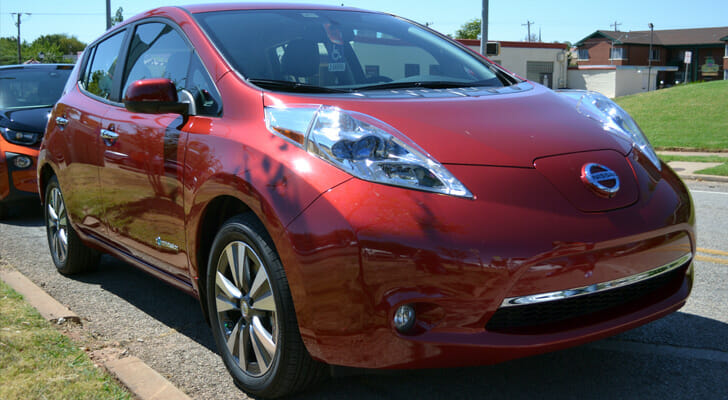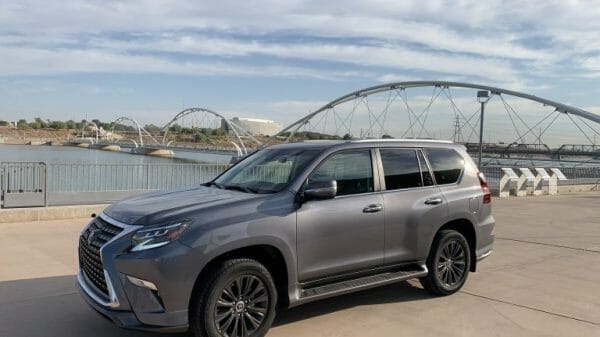Despite the success of the Tesla brand, many automotive buyers are stuck with an outdated mindset regarding electric vehicles. The stereotype created two decades ago by the EV1 still exists, and electric cars are seen as a slow, ugly, and heavily compromised economy car. National Electric Drive Week takes place mid-September and is “a nationwide celebration to heighten awareness of today’s widespread availability of plug-in vehicles and highlight the benefits of all-electric and plug-in hybrid-electric cars.” In other words, they let you drive them, so you will buy one. I drove all of them back to back. I didn’t buy one, but I’m now thinking about it.
Nissan LEAF

The cheapest vehicle at the event was also the most surprising. First impressions of the compact LEAF aren’t great. It looks like the ugly little brother of the Prius C, and implies that you are about to get into a rolling penalty box. Plus the all caps name seems like it’s shouting at you. LEAF!! What’s with that Nissan?
Still, there are quite a few bonuses to what looks like a conventional economy car. Ingress and egress are completely normal, for normal sized adults. Headroom is impressive, even if you are 6’3”, there is plenty of room left for your trucker/cowboy/hipster hat. The seats are unbelievably comfortable. Seriously, I cannot stress enough how fantastic the LEAF’s seats are compared to the competition. They aren’t so hot on side bolstering (but you aren’t going to track this car anyway), but the comfort level is up there with a C-Class. The gauges and center console are modern and stylish, but standard for the class, about what you would expect to find in a Nissan Juke.
Visibility is excellent, as you would expect from a tall economy car. Pulling away from a stop, you notice two things. First, this car is utterly silent, and that’s weird. Second, that it is not slow. Around town, 0 to 30 feels pretty quick if you get on it. Even the cheapest electric car, the base LEAF, accelerates about as well from a stop as a modern four cylinder sedan. There is absolutely nothing to worry about when getting on the highway, as the LEAF can merge with traffic like a proper car. Because it is.
Steering feel and high speed handling aren’t quite up to the Focus, but certainly aren’t bad. The LEAF probably easily out-handles gas cars of similar size, just remember that it wasn’t designed as a sports car.
Ford Focus Electric

The electric Ford Focus variant looks nearly identical to the production gas Focus, with just a few changes in badging. This is a great thing for car buyers that aren’t looking to advertise their eco cred. The current design is decently sporty and unique looking, and the chassis is certainly competent.
The interior sticks to the same theme, looking just like a regular gas Focus. The front seat room is good, most notably the legroom. Ergonomics make sense, and the quality of materials and fit and finish are among the best in class. Visibility is mid-pack, better than the Model S, but not as good as the LEAF.
On the road, the Focus is quiet, with only the occasional odd electric noise. Acceleration is solid due to the instant torque, feeling about on par with the LEAF. Handling is arguably the best of the bunch, excluding the Model S, with great steering feel. Brakes are responsive and predictable. The Ford Focus electric is the ride of choice when you want a very nice compact that looks like every other car out there.
Chevy Volt

The Chevy Volt is infamous for being a sales flop, and while the numbers don’t lie, I believe they are undeserved. While critics made fun of trying to save gas money with a $43,000 car (debut price), make no mistake: this is a solid car. Sure, on initial approach, there’s a lot of third generation Prius in the design, with the current corporate face of Chevy slapped on. A second look reveals that the design is quite a bit sportier looking, with the extra black trim, an overall lower stance and some sweet tail lights.
Getting in, the Volt seems like a Chevy Impala mixed with an iPhone. It’s recognizable as a GM vehicle, but also incredibly slick in presentation. While the outside might say it’s a $25,000 car, the interior declares mid-$40k range. The gauge cluster is one large display, with another above the center cluster. The white is an unusual design touch, and looks slick and expensive. The leather seats are nicely done, comfortable and with snazzy double stitching. This was arguably the best interior in any GM vehicle when the Volt launched in 2011.
The Volt was fully charged, so the display said it had almost 40 miles of electric drive left before the gas engine would turn on. In electric only mode, the Volt is predictably quiet, and the torque off the line is impressive. No, it won’t drag race a Tesla, but the battery’s instant torque is amusing to play with at stoplights, especially when the Volt isn’t known for being quick. Sight lines are rather decent, and steering feel and handling aren’t bad. It reminded me of a fat Chevy Sonic. Sporting, but nothing to brag about. This car shows what GM can do when they try.
BMW i3

The Bimmer is the most bizarrely styled of the bunch, loudly announcing that it is different from most small cars, and proudly announcing its eco cred. Like the larger i8, the i3 sports some unusual – but good – looks. The i3 comes in two flavors, one all electric, and another with a range extending gas engine. The version I drove was all electric, with about an 80 mile range. Range extension adds four grand to the $42k base price, but effectively doubles the range.
The interior is pretty slick, looking like something out of Tron. The seats are nicely styled, comparable to the Tesla in style and comfort. The steering wheel is the best of the bunch, appropriately thick and BMW cool. The gauges look weird when the car is off, like a small tablet in place of the missing gauges.
While driving, the first thing you might notice is the unusually stiff chassis. I had grown accustomed to the EV quietness by this time, but the BMW is a solid ride. The chassis is made from carbon fiber reinforced plastic, providing high strength and light weight. The rest of the experience is typical BMW, with communicative steering, and competent handling. This is no M3, but its handling blows away any other small car. Speed isn’t really there, as this car wasn’t designed for it, but it feels mid-pack between the LEAF and Model S. It’s no sports car, but it is certainly an acceptable for a hyper efficient commuter. Get the range extended version, and you still have the hyper efficient commuter, but can gas up as needed.
Tesla Model S 85D

The P85D didn’t show, so the more responsible version with more range was the test drive vehicle here. Without a doubt, simply the best looking electric car made (since the ELR or i8 also wasn’t there to judge). Tesla succeeded in designing an expensive car that looks like an expensive car. You are getting what you pay for here, with an exotic front end, and great rear curves, with a badge change this could pass for the entry level Maserati.
The sexy design does produce some limitations. An adult getting into the rear of the Tesla faces a contortionist test, so this isn’t the ride for carpooling with other adults. They will complain. Seats are an attractive design and comfortable, yet oddly not to the comfort level of the LEAF. Head, hip, and leg room up front is great, making this car road-trip capable for two adults. Ergonomics are good, and the massive iPad-like screen is impressive. Still, the interior seems slightly lacking for the price, as the similarly priced 7-Series and S-Class blow it away. That steering wheel looks like it came from a $30,000 Nissan, not an $80,000 luxury electric. Still, minor quibbles when looking at the performance for the dollar.
Driving the Model S is an experience. There is no key, or even engine start button. Get it with the electric key, and the car will silently start. The seating position is very adjustable, and it was easy to find a comfortable position for a long drive. Visibility is about what you would expect on a car of this size; good, but not great. The motor is utterly silent at low speeds, and cruising around town all you hear is slight road noise. Silence is luxury now. Handling is surprisingly good for such a large car, due to the extremely low center of gravity. Acceleration is flat out phenomenal. From a stop, hammer the accelerator, and the car is instantly launching you forward. There is an electric whine, but it is far out of place compared to the sheer violence that is smashing you into your seat. That’s where the value of the Tesla comes in. It is cool looking, and will seriously save you some gas money, but the acceleration shenanigans are what make this car a performance bargain. Simply put, there is no car in its price range that can out accelerate the Tesla Model S P85D to 60. There is no car in its class – at any price – that can out accelerate the P85D to 60. Tesla is showing us the future.
In conclusion, after comparing all the electric vehicles back to back, there is no clear winner. If you are looking for the cheapest way to go electric, go with the LEAF. If you stick with less than 80 miles a day (the vast majority of Americans do), you will love the comfortable seats and the gas savings. If you have range anxiety, and need a road trip car, look at the Volt or the range extended i3. Specifically, get the Volt if you haul adults or older kids, and buy the i3 if you must have excellent driving dynamics. Finally, if you can afford the Tesla, any version of the Model S is hard to pass up. It’s a comfy cruiser with a cool interior, good looks, and flat out insane acceleration. No matter which one you chose, you still win. The ‘90s and their garbage electric vehicles are long gone. Now the above cars are pointing the way to the future. A future where electric cars are every bit as fun as the best of the past.












